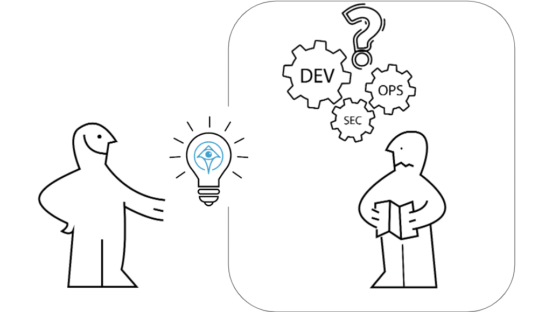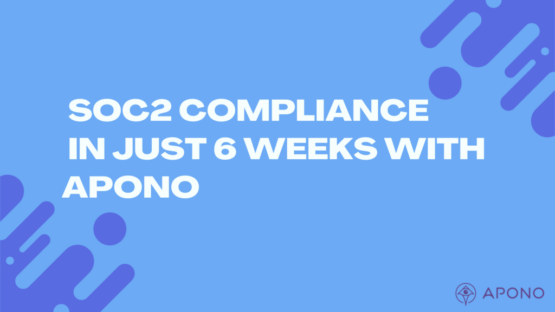Kubernetes RBAC Essentials: How to Enable and Manage Access

Ofir Stein
May 8, 2024
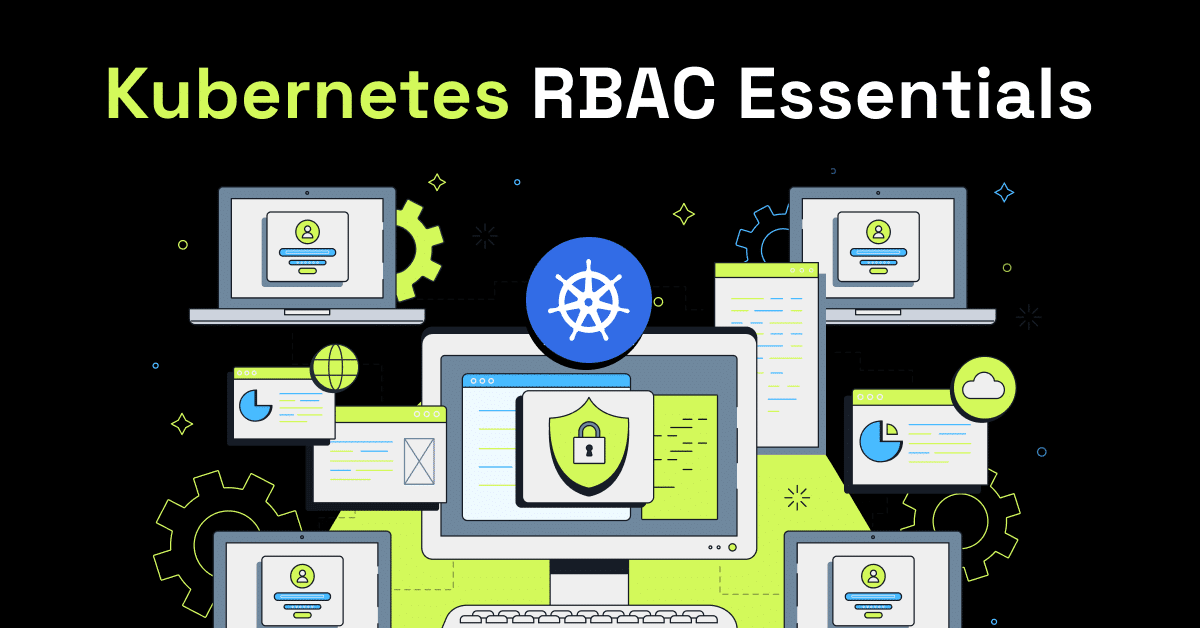
As the number of applications and participants grows within your cluster, it may be necessary to evaluate and limit the activities they can perform. For instance, you may consider restricting access to production to only a select few individuals. Alternatively, you may opt to provide a limited range of permissions to an operator deployed within the cluster.
By leveraging the rbac.authorization.k8s.io API group, Kubernetes RBAC enables dynamic configuration of access policies, ensuring compliance and enhancing security by precisely defining who can do what within the system.

What Is Kubernetes RBAC?
Kubernetes RBAC (Role-Based Access Control) is a fundamental security feature that manages access to resources within a Kubernetes environment based on the roles assigned to individual users. It is designed to restrict access to Kubernetes resources by assigning granular roles to users, enhancing security and compliance within an organization.
Roles and RoleBindings
- Roles and ClusterRoles: Kubernetes distinguishes between two types of roles:
- Roles: These are permissions confined to a specific namespace, allowing users to perform actions only within that namespace.
- ClusterRoles: These apply to the entire cluster, providing permissions that span across all namespaces.
- RoleBindings and ClusterRoleBindings: These elements link roles to users or service accounts, effectively determining who can access what resources:
- RoleBindings: Connect Roles to users within specific namespaces.
- ClusterRoleBindings: Link ClusterRoles to users, granting permissions across the entire cluster.
Permissions and Verbs
Permissions in Kubernetes RBAC are managed through verbs that define specific actions that accounts can perform on resources. These verbs include actions like get, list, create, update, and delete. This flexible system allows administrators to finely tune access rights, ensuring users only have the permissions necessary for their roles.
Accounts and Authentication
Kubernetes RBAC supports two types of accounts:
- User Accounts: These represent human users and are typically managed externally but authenticated through Kubernetes when accessing the cluster.
- Service Accounts: Used by software processes running in pods, these accounts are managed by Kubernetes and tied to specific namespaces.
Dynamic Configuration Through API
Kubernetes RBAC uses the rbac.authorization.k8s.io API group to drive authorization decisions, allowing administrators to dynamically configure policies directly through the Kubernetes API. This capability is essential for adapting to changing access requirements within dynamic environments.
RBAC is enabled by default in Kubernetes, reflecting its integral role in securing Kubernetes environments by ensuring that access to resources is tightly controlled and aligned with individual roles within an organization. This system not only secures the cluster but also organizes user access according to clear, manageable policies.
Enabling Kubernetes RBAC
To ensure that Kubernetes RBAC is activated in your production environment, it is crucial to configure the API server correctly. Follow these detailed steps to enable RBAC, verify its activation, and ensure your cluster’s security and compliance.
Step-by-Step Instructions to Enable RBAC
- Start the API Server with RBAC Enabled:
- Initiate the API server with the –authorization-mode flag. This flag should include RBAC in a comma-separated list of values to ensure RBAC mode is active.
- Verify RBAC is Enabled:
- To confirm that RBAC is functioning, use the kubectl command line tool. Execute kubectl api-versions; if RBAC is correctly enabled, you will see the API version .rbac.authorization.k8s.io/v1 listed in the output.
Checking RBAC Status on Azure Kubernetes Service (AKS)
- For clusters hosted on Azure (AKS), you can verify RBAC status by accessing the cluster’s resource details at resources.azure.com. Look for the “enableRBAC”: true setting in the configuration details to confirm that RBAC is enabled.
These steps are essential for maintaining a secure Kubernetes environment, ensuring that access controls are enforced and aligned with organizational security policies. By following these instructions, administrators can effectively manage access rights within the cluster.
Defining Roles and Permissions
In Kubernetes, defining roles and permissions is a critical step to ensure that access to resources is both secure and compliant with organizational policies. Here’s how roles and permissions are structured and managed in Kubernetes RBAC:
Understanding Roles and ClusterRoles
- Roles:
- Roles are namespaced objects that define permissions within a specific namespace.
- They are a collection of permissions that allow users to perform specific actions on a defined set of Kubernetes resource types.
- ClusterRoles:
- ClusterRoles are similar to Roles but are not namespace-specific.
- They provide permissions that span across all namespaces and are essential for managing cluster-level resources like Nodes.
Creating and Managing Roles
- Keep Roles Precise:
- Roles should contain only the minimum set of permissions necessary for the tasks they represent to enhance security.
- Avoid Using Wildcards:
- Avoid using the ‘*’ wildcard in roles and verbs fields to prevent overly broad permissions that could compromise security.
- Dynamic Configuration:
- Use the kubectl auth reconcile command to manage binding objects, especially when changes to roles are required.
Best Practices for Defining Permissions
- Specificity in Permissions:
- Define permissions as specifically as possible to limit access to only what is necessary.
- Use of ClusterRoles:
- Utilize ClusterRoles for broader permissions across the cluster, especially for non-namespaced resources and global access to namespaced resources.
- Management of Non-Resource Endpoints:
- ClusterRoles and ClusterRoleBindings are also useful for granting permissions to non-resource endpoints like /healthz.
By following these guidelines, Kubernetes administrators can effectively manage roles and permissions, ensuring a robust security posture and compliance with organizational policies.
Creating RoleBindings and ClusterRoleBindings
RoleBindings and ClusterRoleBindings are essential tools in Kubernetes for managing and assigning permissions across different scopes within a cluster. This section will guide you through the process of creating these bindings, ensuring that permissions are correctly assigned to users or groups, thereby maintaining security and compliance within your Kubernetes environment.
Understanding RoleBindings and ClusterRoleBindings
RoleBindings and ClusterRoleBindings utilize the rbac.authorization.k8s.io API group to manage authorization decisions effectively. Here’s how they differ and function:
- RoleBindings:
- Scope: Namespace-specific.
- Function: Grants permissions defined in a Role to users or groups within a specific namespace.
- Example: A RoleBinding can reference any Role within the same namespace or even a ClusterRole, restricting it to the namespace scope of the RoleBinding.
- ClusterRoleBindings:
- Scope: Cluster-wide.
- Function: Grants permissions defined in a ClusterRole to users or groups across all namespaces.
- Example: A ClusterRoleBinding allows for broad permissions across the entire cluster.
Step-by-Step Guide to Creating RoleBindings
To create a RoleBinding, follow these steps:
- Define a Role:
- Ensure the Role or ClusterRole you wish to bind is already defined.
- Prepare the RoleBinding YAML Configuration:
- Use the following template to create a RoleBinding:
- apiVersion: rbac.authorization.k8s.io/v1
kind: RoleBinding
metadata:
name: example-rolebinding
namespace: webapps
subjects:
– kind: ServiceAccount
name: app-service-account
namespace: webapps
roleRef:
apiGroup: rbac.authorization.k8s.io
kind: Role
name: app-role
- Apply the Configuration: Use kubectl apply -f <filename>.yaml to create the RoleBinding in your cluster.
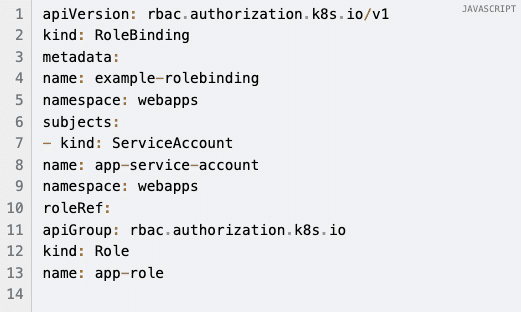
Step-by-Step Guide to Creating ClusterRoleBindings
Creating a ClusterRoleBinding involves similar steps but with a scope that extends across the entire cluster:
- Define a ClusterRole:
- Verify that the ClusterRole exists or create one if necessary.
- Prepare the ClusterRoleBinding YAML Configuration:
- Here is a template for a ClusterRoleBinding:apiVersion: rbac.authorization.k8s.io/v1
kind: ClusterRoleBinding
metadata:
name: example-clusterrolebinding
subjects:
– kind: ServiceAccount
name: app-service-account
namespace: webapps
roleRef:
apiGroup: rbac.authorization.k8s.io
kind: ClusterRole
name: cluster-admin
- Here is a template for a ClusterRoleBinding:apiVersion: rbac.authorization.k8s.io/v1
- Apply the Configuration:
- Execute kubectl apply -f <filename>.yaml to implement the ClusterRoleBinding in your Kubernetes cluster.
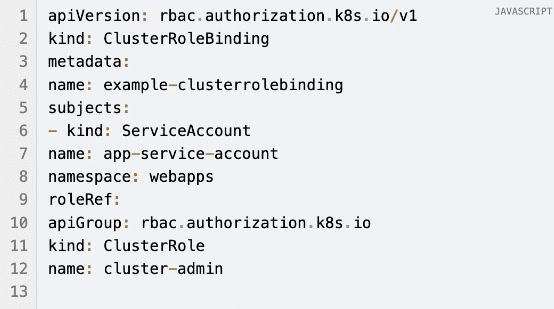
By following these steps, administrators can effectively manage access within Kubernetes, ensuring that only authorized users and services have the necessary permissions to perform their functions securely and efficiently.
Practical Challenges of Kubernetes Role-Based Access Control
In Kubernetes, RBAC serves as a pivotal tool for finely tuning user permissions. However, while you strive to allocate access, you’ll likely encounter several common hurdles:
- Manual Role Configuration: Kubernetes lacks native mechanisms for automating role assignment or updating role bindings. Consequently, administrators must manually configure each role binding for new team members or namespaces. Updating roles necessitates recreating and substituting existing roles, while access revocation mandates manual deletion of users’ RoleBinding configurations. This manual overhead, compounded as teams expand, increases the likelihood of errors such as duplicate role grants, complicating the process of role revocation.
- Limited Visibility into Cluster Configurations: Kubernetes also falls short in providing tools to manage intricate RBAC setups effectively. Administrators are tasked with manually tracking Roles, RoleBindings, ClusterRoles, ClusterRoleBindings, ServiceAccounts, Groups, and tokens stored as Secrets, among other configurations.
- Limited Visibility into User Access: Kubernetes lacks built-in utilities for readily discerning users’ access levels within a cluster. While administrators can manually inspect role binding configurations, there’s no centralized method for tracking this information across the cluster. Consequently, administrators may inadvertently create unused roles or assign roles to non-existent subjects within the cluster. This surplus configuration data further obscures visibility into roles across the cluster.
In essence, Kubernetes RBAC lacks robust support for managing and monitoring configuration data, necessitating a robust strategy to mitigate the manual efforts associated with RBAC management in Kubernetes.
Kubernetes RBAC with Apono
With Apono, organizations can easily define roles and permissions for their Kubernetes clusters. They can create custom roles that align with their specific requirements and assign those roles to different users or groups. Apono provides a graphical interface that makes it easy to visualize and manage RBAC policies, simplifying the process of granting and revoking access to resources within the cluster.
One of the key benefits of using Apono for Kubernetes RBAC is its ability to enforce fine-grained access control. Organizations can define granular permissions for different resources, such as pods, services, or namespaces. This level of control allows them to restrict access to sensitive resources and ensure that only authorized individuals can interact with them. Apono also provides auditing capabilities, allowing organizations to track and monitor user activity within the cluster.
Another advantage of using Apono for Kubernetes RBAC is its integration with other identity management systems. Apono supports integration with popular identity providers like Azure AD or Okta, allowing organizations to leverage their existing user management infrastructure. This integration simplifies user onboarding and offboarding processes, as well as ensures consistent access control across different platforms.
Enforcing Kubernetes access control across multiple clusters presents a unique set of challenges, particularly when it comes to duplicating and configuring roles consistently. This is a task that requires a robust and centralized management system. Apono provides a solution that simplifies this process, offering an efficient way to manage access controls at scale. Apono’s platform is designed to integrate seamlessly with multiple Kubernetes clusters, allowing system administrators to set up and enforce access policies from a single control point. It streamlines the process of role duplication and configuration across clusters, ensuring that each cluster adheres to the organization’s security protocols and compliance standards without the need for repetitive manual effort. By adopting such a centralized approach, organizations can benefit from streamlined processes and improved security management in their multi-cluster Kubernetes environments.
Kubernetes RBAC with Apono offers organizations a comprehensive solution for managing access control within their Kubernetes clusters. With its intuitive interface, granular permissions, and integration capabilities, Apono simplifies the process of defining and enforcing RBAC policies. By using Apono, organizations can enhance the security of their Kubernetes environments and ensure that only authorized users have access to critical resources.


